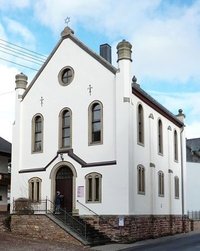Unfortunately, the origin of this pocket spring scale can’t be traced, but it is symbolic for the accoutrements carried by many itinerant Jewish merchants in the early 19th Century. The small spring scale was easy to transport and featured a ring for suspending the scale and a hook for hanging the product to measure its weight. This particular pocket spring scale was discovered in an antique shop in Jerusalem, where the shop owner confirmed that its origins were from the Rhineland in Germany.
While Worms, Mainz and Speyer formed the core of European Judaism throughout the Middle Ages, the Jews in the larger cities were eventually driven out due to the frequent, plague-related pogroms and anti-Jewish persecutions of the High Middle Ages, and were forced to settle in the smaller villages and communities in the surrounding areas. Rural Judaism had culminated in the 19th Century with around 90% of the Jews in Germany living in the villages and small towns when a gradual migration back to the cities began. Only a few Jews were allowed to own land at this time, whereby this was barely possible anyway because of the small-scale agriculture and land partitioning. For this reason, most Jews were merchants travelling from village to village, carrying their haberdasheries on their backs, or supplied their small-town market customers with kosher products, grain, wine, tobacco wood or small industrial goods. They played a particularly large role in the cattle trade and, being referred to as „Viehjuden” (cattle Jews), they shaped the market activities in Kirchberg, Simmern and Kastellaun until 1933.
en

